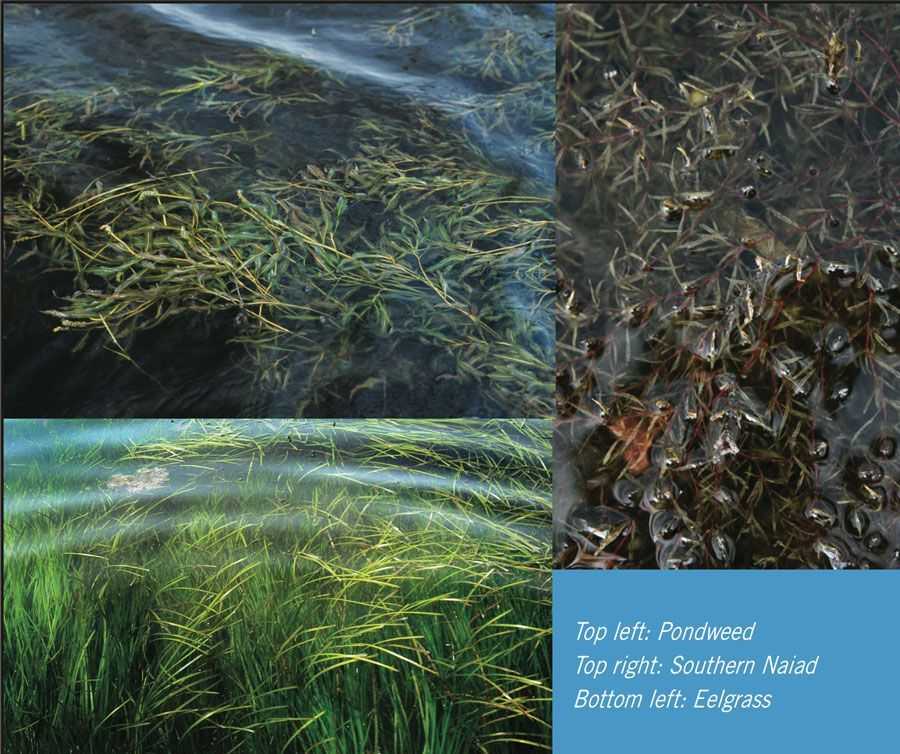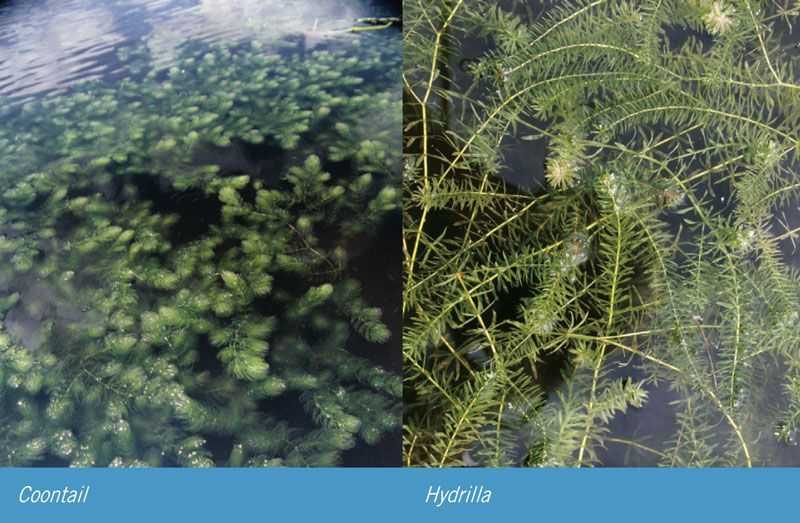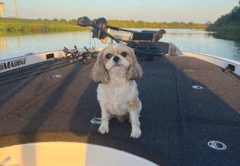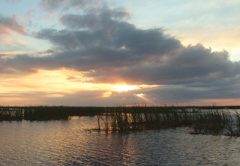To date, we have identified four zones of vegetation in Lake Okeechobee and lakes in general; the Emergent Zone, the Floating Leaved Zone, the Submersed Zone, and the Free Floating Zone. Today we discuss a lake’s Submersed Zone.
Plants typically associated with the Submersed Zone have their roots secured to the lake’s bottom and their leaves remain mostly beneath the surface of the water. Being located in deeper water, these plants provide refuge and forage for fish, small animals, and birds. This makes these zones vital to the health of the ecosystem. To grow, submersed plants require light to penetrate the water column, so they are affected by water clarity and depth. During the growth cycle they are a producer of oxygen. However during turbid conditions or consecutive cloudy days, they can quickly turn into a consumer of oxygen which will have a negative impact on holding bass.
Some plant species resident to Lake Okeechobee include; Pondweed which is also known as Peppergrass, Eelgrass also known as Tapegrass or Ribbongrass, Southern Naiad as known as Bushy Pondweed, Coontail also known as Hornwort, and Hydrilla.
Pondweed roots itself deep into the lake’s bed. Its branching stems are soft and the leaves are thin and nearly transparent. In the summer, flower spikes emerge which produce plump seeds that are eaten by diver and puddle ducks. Stands of Pondweed are home to grass shrimp, segmented worms, midgets, and many other insects. This creates prime feeding ground for hungry bass. Being that Pondweed has larger leaves than other aquatic species in the lake, you’ll find plenty of openings to drop in a weighted worm or creature bait to the bottom, or work a weedless top-water plug or frog across the surface.
Eelgrass has dark green ribbon-like leaves that are a 1⁄2-inch wide and more than 3-feet long. These leaves grow from stems that run and root along the bottom of the lake. When left undisturbed, eelgrass will grow into dense underwater beds that create some of the best habitats for fish and insects on the lake. Eelgrass beds are generally quite open, and adaptable to many different styles of fishing such as; shallow crank baits, spinner baits, buzz baits, swim jigs, worms, creature baits, and even top water plugs on a calm day. Since there is no canopy for the bass to hide under, you’ll need to cover a lot of water to locate holding bass, so a faster retrieve works well
here. Once you locate fish, vary up your rate of retrieve to cover the entire water column. Being Eelgrass beds are such an important component of Lake ‘O’s ecosystem, boaters and fishermen should respect the grass beds and proceed with caution and do no harm to these sensitive areas.
Southern Naiad looks like thin branching twigs with dark green to greenish-purple leaves. When lifted out of the water, it is very soft and collapses upon itself. During its reproductive cycle, a large pod-like seed forms which is food for dabbling and diving ducks. Though large colonies will form mats, the canopy is generally less dense than Hydrilla and can be penetrated with weighted worms, creature baits, and weedless jigs. Working a weedless frog across the top of the mat can also be effective.
Coontail consist of branching masses of stiff leaf strands that grow underwater without being rooted to the lakes bottom. The leaves are dark olive-green and point toward the end of the branch. It derives its name from the ‘raccoon tail’ look of the outer bristly leaf structure. Having little to no root system, it forms a canopy type cover and normally colonizes in backwaters and places with low water exchange. Therefore oxygen levels will vary greatly during the day and under gray cloudy conditions. Weedless swim baits, weedless jigs, weighted worms, and creature baits are the lures of choice for these areas.
EITHER YOU ARE GOING TO FISH YOUR BAIT HORIZONTALLY THROUGH THE WATER COLUMN OR ACROSS THE TOP OF THE WATER OR MAT’S SURFACE, OR YOU’RE GOING TO FISH VERTICALLY AND GET YOUR BAIT THROUGH THE CANOPY AND TO THE LAKE’S BOTTOM. IN REALITY, YOU’LL END UP DOING BOTH, BUT ONLY UNDER THE RIGHT CONDITIONS.
Hydrilla though beneficial in small quantities is actually an invasive plant and considered a ‘noxious weed.’ It grows in tangled strands that branch horizontally underwater and extend upward at the same time. It has strap- like tiny pointed leaves with saw-tooth like edges that spike themselves from the main stem. The presence of small barbs on the bottom of the leaf gives the plant a rough feel. Hydrilla will grow into dense mats that float at the surface and can become impenetrable to light, fishing tackle, and even boats. What makes this plant so dangerous to ‘native’ plants is that it grows well under poor light, stained, and turbid water conditions and can quickly overtake less adaptive species. When Hydrilla patches are in their early growth cycle, such as late spring-early summer, these can be productive hot spots for the fast growing plant will provide shelter for new spawned bait fish and insects. Depending on the density of the plant colony, swim baits, weedless jigs, weighted worms, and creature baits will all produce fish. As the colony matures, heavier weights will be needed to penetrate the developing mat canopy. Once the colony is fully mature, unless you find holes in the canopy, getting your bait through the mat will be next to impossible so move on to better fishing grounds.
With all these species of plants, a novice fisherman could be easily intimated as to how to fish the different plants, but we can boil it down to just a few simple concepts. Either you are going to fish your bait horizontally through the water column or across the top of the water or mat’s surface, or you’re going to fish vertically and get your bait through the canopy and to the lake’s bottom. In reality, you’ll end up doing both, but only under the right conditions.
When fishing the outside edges of a submerged plant colony or eelgrass bed, you can choose a lighter action rod and a high-speed reel loaded with monofilament line since you’ll have to cover more water and have fewer obstructions to contend with. However once you change and start casting into the weed beds, you’ll need a rod with a stiff back bone, a reel with more power, braided line in the 50-65 lb. class, and stout hooks. Bass in these areas do not come out easily and most of the time you’ll be bringing a bushel of weeds to boot. A key tip to remember when flipping or pitching is to keep the cast short so that you don’t have to work your way through a lot of weeds and always move the bait with your rod and not your reel. Lift the rod up to move the bait and reel in the slack as you lower the rod. This ensures the bait remains close to the bottom.
Unless you’re already familiar with the lake, you’ll need to decide where to start fishing. Some key things to look for are working birds, clarity of water, current, wind direction, underwater structure, and the convergence of different plant life. Bass in Lake Okeechobee are constantly on the move but that doesn’t mean they move great distances. They move according to the conditions, the underwater structure, and their reproductive cycle. For example, during the heat of the summer, bass might move out into the lake a night for cooler water and to forage for bait fish, but during the mid- day heat they seek out shade under a vegetation canopy. The point is, it’s a process driven by timing and conditions. During the morning you’d want to be fishing the edges and the channels that provide access between open water and the shade canopies. As the day gets longer you move closer to, then into, the vegetation as the bass does.
Fishing in south Florida and the shallow lakes like Lake Okeechobee and Lake Istokpoga is all about the vegetation. For each plant species there is a time and place for producing quality fish. To become proficient at it is a matter of a little education and a lot of practice, and I never hear too many people complaining about practicing the art of fishing.








